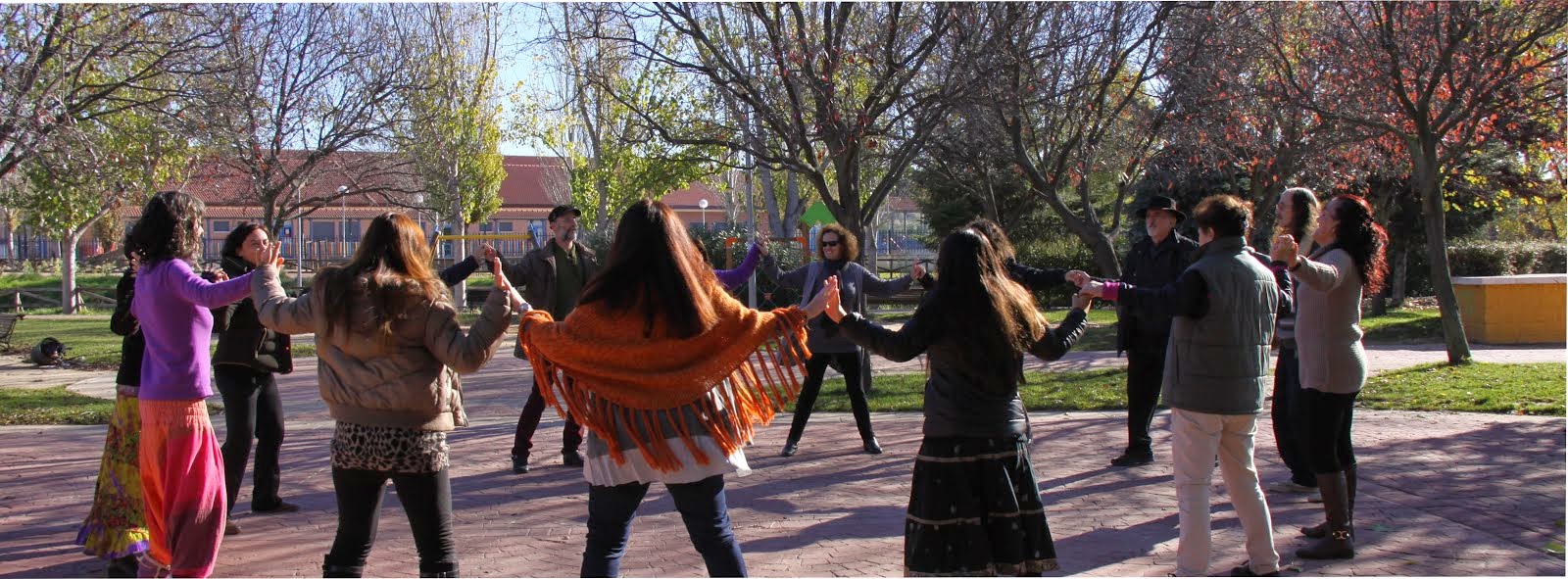Colocación de los brazos
In Brittany, music and dancing have always been an expression of identity for the folk society. They were a particular moment favouring the expression of individuals who fused together through a happy time. They followed the different stages of life and structured its organisation. Yet the practice of dancing and music was not restricted to a pure entertainment. It was the manifestation of the folk social order which expressed through a collective activity the status of each individual within the community.
The circular form, the typical pattern of the most dominant dance in the western Brittany repertoire, is very representative of the social structure. The circle is the representation of a community which can express itself only if each dancer is at the right place. The individual is both a minor and a vital element in the working order of the dancing and singing.
Dancing and singing convey the expression of an identity. This is the fundamental character which has permitted to Breton culture to develop through ages by adapting to the continuous cultural evolution. It also explains the current extraordinary enthusiasm of thousands of Bretons who today keep practicing music an dancing, thus perpetuating a centuries old tradition.
In the agricultural society of the 19th Century, the most common occasion on which dancing took place was a wedding. Other opportunities for dancing were:
The circular form, the typical pattern of the most dominant dance in the western Brittany repertoire, is very representative of the social structure. The circle is the representation of a community which can express itself only if each dancer is at the right place. The individual is both a minor and a vital element in the working order of the dancing and singing.
Dancing and singing convey the expression of an identity. This is the fundamental character which has permitted to Breton culture to develop through ages by adapting to the continuous cultural evolution. It also explains the current extraordinary enthusiasm of thousands of Bretons who today keep practicing music an dancing, thus perpetuating a centuries old tradition.
In the agricultural society of the 19th Century, the most common occasion on which dancing took place was a wedding. Other opportunities for dancing were:
- beating the earth floor of a new house or repairing a damaged beaten earth floor
- preparing a threshing floor
- celebrations following agricultural work (such as a harvest festival)
- secular celebrations accompanying a religious festival (such as a pardon)
More recently, throughout the second half of the 20th Century, a revival of traditional Breton dancing has taken place, to such an extent that it can now be considered to be at the forefront of contemporary Breton cultural expression, along with the music which accompanies it.
Two main opportunities exist to experience Breton dance: fest-noz (night festival) and fest-deiz (day festival). The former reunites both young and old in a celebration of their cultural heritage, whereas the latter tends to be frequented by a somewhat older collection of people. Moreover, the range of dances found at a fest-noz is likely to be smaller; at a fest-deiz the full variety of Breton dance can often be seen, including dances in fours and eights which rarely get an outing at a fest-noz.
Breton dance is accompanied by musicians and singers playing and singing in duos, trios, quartets and, sometimes, even larger groups. Traditional acoustic instruments are often the mainstay of these occasions, though some groups have also taken up electric instruments as well. The most ubiquitous instruments are the accordion and two characteristically Breton wind instruments: the biniou (a kind of bagpipe) and the bombarde (a reed instrument similar to the oboe).
Two main opportunities exist to experience Breton dance: fest-noz (night festival) and fest-deiz (day festival). The former reunites both young and old in a celebration of their cultural heritage, whereas the latter tends to be frequented by a somewhat older collection of people. Moreover, the range of dances found at a fest-noz is likely to be smaller; at a fest-deiz the full variety of Breton dance can often be seen, including dances in fours and eights which rarely get an outing at a fest-noz.
Breton dance is accompanied by musicians and singers playing and singing in duos, trios, quartets and, sometimes, even larger groups. Traditional acoustic instruments are often the mainstay of these occasions, though some groups have also taken up electric instruments as well. The most ubiquitous instruments are the accordion and two characteristically Breton wind instruments: the biniou (a kind of bagpipe) and the bombarde (a reed instrument similar to the oboe).
Este baile, junto con otros, eran utilizados para apisonar el suelo:
- dentro de las casas con piso de tierra,
- fuera de las casas, en el patio de la granja, el terreno de trilla del trigo.
Otros bailes tenían el mismo fin:
- An dró
- Le Pilé menu,
- Las gavottes.
Incluso el recorrido habitual de estas danzas era modificado para crear unas cadenas de bailarines que recorrieran todo el terreno a allanar, desde el centro a las esquinas.

